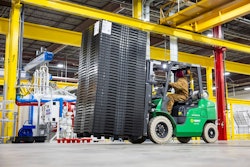
Distribution is faster, leaner—and more fragile than ever before. A single delay can ripple across many touchpoints in a supply chain network. So how do you make the right move, every time, at scale? That’s where machine learning steps in.
In today's volatile and fast-moving supply chain environment, quickly adapting to disruptions and shifting demand patterns is essential. Machine learning (ML) is taking operational execution to a new level. No longer just a strategic forecasting tool, ML now powers intelligent, real-time decisions that optimize inventory, labor, and warehouse orchestration.
The role of machine learning in modern supply chains
ML uses algorithms that learn from historical and real-time data to make intelligent decisions. Machine learning algorithms ingest large volumes of structured and unstructured data—from ERP, WMS, TMS, and IoT sensors—to uncover patterns and make data-backed predictions. ML adapts over time, improving its accuracy and performance as more data becomes available. This allows the models to detect inefficiencies, recommend actions, and rapidly adjust to ever-changing conditions. In supply chains, it enhances execution by optimizing inventory, forecasting demand, allocating labor, and orchestrating warehouse operations—resulting in greater efficiency, agility, and resilience across the entire logistics network.
Machine learning in execution vs. planning
Traditional ML applications in supply chains focus on forecasting, demand planning, and strategic sourcing. However, the real power of ML emerges when applied to execution processes. These models enable execution-level optimization by:
· Prioritizing work orders based on evolving conditions
· Dynamically adjusting labor schedules to meet throughput goals
· Re-optimizing inventory placement and replenishment strategies in real-time
· Mitigating risks such as missed service levels or congestion at docks
Although the decisions driven by ML may seem small at times, they deliver compound benefits across an enterprise. In a high-volume, high-velocity distribution center, even minor labor deployment or order sequencing optimizations can have a significant bottom-line impact.
Use cases of machine learning in supply chain execution
Warehouse orchestration. ML models orchestrate the real-time flow of people, inventory, and equipment. For example, if a shipment is delayed, ML can reprioritize dock schedules, reassign labor to higher-value tasks, or reroute inventory to meet outbound SLAs. These models continuously learn from historical and real-time data—like traffic patterns or task completion rates—to minimize congestion and boost throughput. The result is a fluid, responsive warehouse that automatically adapts to shifting priorities and demand.
ML can also preposition inventory based on predicted picking patterns, dynamically assign docks based on arrival times, and optimize task handoffs between human and robotic systems.
Inventory allocation and replenishment. ML enhances replenishment strategies by analyzing real-time and historical data to predict inventory needs accurately. It considers factors like SKU velocity, seasonality, lead times, order patterns, and even external influences such as weather or promotions. ML dynamically adjusts reorder points and quantities based on demand fluctuations and supply chain constraints. This reduces stockouts and overstock, optimizes safety stock levels, and ensures timely replenishment. ML enables a more responsive, data-driven approach that improves product availability, shortens replenishment cycles, and lowers carrying costs across the distribution network.
Labor optimization. ML optimizes warehouse labor by forecasting demand and aligning staffing needs in real-time. For example, an ML model can analyze historical pick rates, shift performance, absenteeism, and incoming order volume to predict the optimal number of workers needed for each task and time slot. It dynamically adjusts assignments based on workload changes, ensuring that labor is neither over- nor underutilized. During peak periods, the system may reallocate staff from low-priority tasks to urgent orders. This intelligent scheduling reduces overtime, improves productivity, and minimizes downtime, enhancing operational efficiency and workforce satisfaction in fast-paced distribution environments.
Order fulfillment sequencing. ML enhances order fulfillment sequencing by continuously analyzing order characteristics, inventory availability, labor capacity, and shipping deadlines to prioritize real-time tasks. Instead of processing orders in the sequence received, ML identifies the most efficient order-picking path to meet service-level agreements and reduce touches. For instance, it may group similar SKUs or prioritize high-value or time-sensitive orders based on predicted lead times and congestion patterns. As new orders arrive or delays occur, the system re-optimizes the sequence instantly. This dynamic sequencing reduces cycle times, minimizes errors, and improves customer satisfaction by ensuring timely and accurate deliveries.
Real-world benefits and measurable outcomes
Companies implementing ML in the supply chain have reported measurable gains, including:
· 15-25% increase in labor efficiency
· 10-20% improvement in dock throughput
· 20-30% reduction in missed service levels and OTIF penalties
ML enables operations teams to shift from being reactive to proactive execution. Its ability to continuously learn and refine recommendations makes it ideal for fast-paced, complex environments.
The road ahead for ML in supply chain execution
ML is no longer confined to demand planning or strategic modeling. The future of machine learning in supply chain execution lies in deeper automation, real-time decision-making, and greater system interoperability. As data becomes richer and more accessible, ML models will evolve to make more autonomous, context-aware decisions—optimizing labor, inventory, and transportation without human intervention. Integrating ML with robotics, IoT, and cloud platforms will enable end-to-end orchestration from warehouse to customer. Advances in explainable AI will build trust and transparency in ML-driven operations.
ML is no longer a future vision—it’s a present necessity. And soon, the best-run warehouses won’t just be automated—they’ll be thinking.




















